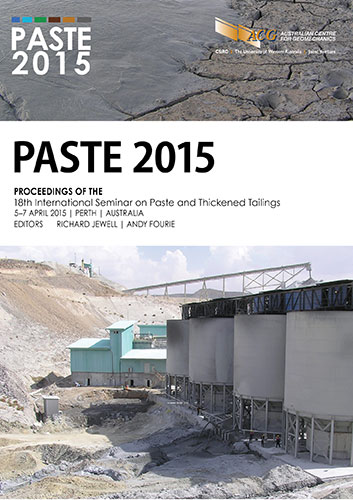Management of bauxite residue in a temperate climate using mud‑farming techniques

|
Authors: Willan, MB; Ghataora, GS |
DOI https://doi.org/10.36487/ACG_rep/1504_14_Willan
Cite As:
Willan, MB & Ghataora, GS 2015, 'Management of bauxite residue in a temperate climate using mud‑farming techniques', in R Jewell & AB Fourie (eds), Paste 2015: Proceedings of the 18th International Seminar on Paste and Thickened Tailings, Australian Centre for Geomechanics, Perth, pp. 209-222, https://doi.org/10.36487/ACG_rep/1504_14_Willan
Abstract:
The management of water within the mining waste industry is one of the most critical factors affecting operators today. Long-term sustainable management will both increase the volume of waste which can be stored in a given area and decrease the effect on sometimes fragile water supplies. One often overlooked technique, primarily used in the alumina refining industry, is the mechanical consolidation and densification of waste bauxite residue (also known as ‘red mud’ due to its colour) in a process known as mud-farming. This technique provides a simple, less technology–dependent solution as it is carried out by relatively inexpensive mechanical plant. Whilst a number of studies have examined the effectiveness of mud-farming, these studies have been carried out in the comparatively arid climate of South West Australia. Given that this technique may be of interest to the wider mine waste industry, a study into the observed benefits of mud-farming techniques within a temperate climate has been conducted. This study has focused on the mud-farming operations currently carried out at the Rusal Aughinish Alumina facility, near Limerick, Ireland. The study makes use of both historical site investigation data and the results from a site investigation carried out in 2014, using cone penetration testing as well as a complimentary laboratory testing programme. The results of this study demonstrate that the application of mud-farming techniques has led to increases in the both the undrained shear strength and the density of the bauxite residue which will ultimately enable increased capacity at the facility. Furthermore, this study identifies a number of issues arising for the use of standard geotechnical laboratory testing of bauxite residue, including the potential to miscalculate moisture content due to the presence of amorphous particle, and undrained shear strength.
References:
Aluminium Laboratories Ltd n.d., Standard Method 305-61: Determination of real density or specific gravity of powdered materials: pycnometer procedure, Aluminium Laboratories Ltd, Arvida.
Australian Government Bureau of Meteorology 2014, Climate statistics for Australian locations, Perth regional office 1881 to 2010, Australian Government Bureau of Meteorology, Melbourne, viewed 22 May 2014,
British Standards Institution 1990, BS 1377: Methods of test for soils for civil engineering purposes, British Standards Institution, London.
British Standards Institution 1990, BS 1377-2 Part 2, Section 3: Determination of Moisture Content, British Standards Institution, London.
British Standards Institution 2013, BS EN ISO 22476-1:2012: Geotechnical investigation and testing – Field testing – Part 1: Electrical cone and piezocone penetration test, British Standards Institution, London.
Cooling, DJ, Hay, PS & Guilfoyle, L 2002, ‘Carbonation of bauxite residue’, in S Chandrashekar (ed.), Proceedings of the 6th International Alumina Quality Workshop, AQW Inc., Perth, pp. 185-190.
Fourie, AB 1997, ‘Classification and index tests’, in GE Blight (ed.), Mechanics of residual soils, A.A.Balkema, Rotterdam.
Li, H, Pedrosa, S & Canfell, A 2011, ‘Case study – bauxite residue management at Rio Alcan Gove, Northern Territory, Australia©’, in RJ Jewell & AB Fourie (eds), Proceedings of the 14th International Seminar on Paste and Thickened Tailings, Australian Centre for Geomechanics, Perth, pp. 203-212.
Li, LY & Rutherford, GK 1996, ‘Effect of bauxite properties on the settling of red mud’, International Journal of Mineral Processing, vol. 48, pp. 169-182.
Long, M 2007, ‘Engineering characterization of estuarine silts’, Quarterly Journal of Engineering Geology & Hydrogeology, vol. 40, pp. 147-161.
Lunne, T, Robertson, PK & Powell, JJM 1997, Cone penetration testing in geotechnical practice, E & FN Spon, Oxon, UK.
Munro, LD & Smirk, DD 2012, ‘Optimising bauxite residue deliquoring and consolidation’, in S. Rosenberg (ed.), Proceedings of the 9th Alumina Quality Workshop, AQW Inc., Perth, pp. 269-275.
Smirk, DD and Jackson, S 2010, ‘In situ foundation improvement for upstream raising of embankments using dried tailings’, in AB Fourie & RJ Jewell (eds), Proceedings of the First International Seminar on the Reduction of Risk in the Management of Tailings and Mine Waste, Australian Centre for Geomechanics, Perth, pp. 251-260.
Sutar, H, Subash, CM, Santosh, KS, Ananta, PC & Himanshu, SM 2014, ‘Progress of red mud utilization: an overview’, American Chemical Science Journal, vol. 4, no. 3, pp. 255-279.
The Irish Meteorological Service 2014, 30 year monthly and annual mean and extreme values for Shannon Airport 1961 to 1990, The Irish Meteorological Service, Dublin, viewed 22 May 2014,
Vick, SG 1990, Planning, design, and analysis of tailings dams, BiTech Publishers Ltd, Vancouver.
© Copyright 2025, Australian Centre for Geomechanics (ACG), The University of Western Australia. All rights reserved.
View copyright/legal information
Please direct any queries or error reports to repository-acg@uwa.edu.au
View copyright/legal information
Please direct any queries or error reports to repository-acg@uwa.edu.au